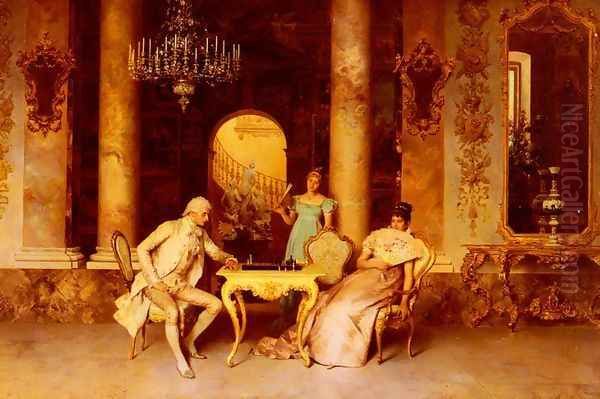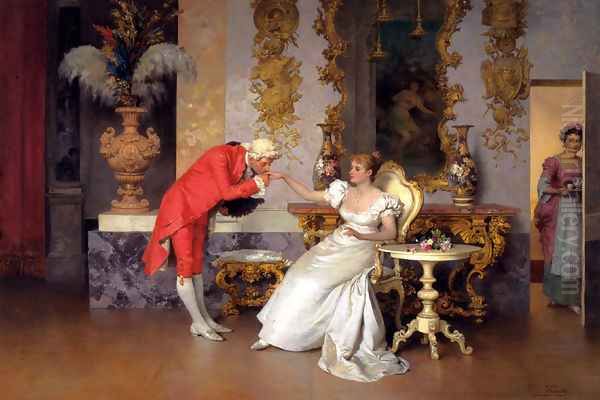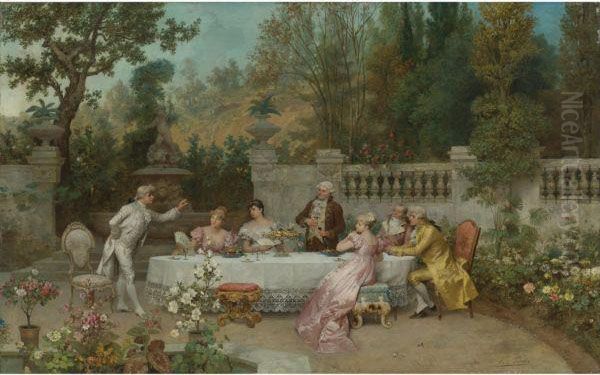Francesco Beda (1840-1900) stands as a significant, if sometimes overlooked, figure in the landscape of late 19th-century Italian art. Flourishing during a period of immense social and cultural transition, Beda carved a distinct niche for himself with his exquisitely detailed and charmingly narrative "costume genre" paintings. These works, often depicting scenes of aristocratic leisure and romantic encounters set in opulent interiors of previous centuries, resonated deeply with the tastes of a newly affluent bourgeoisie and a lingering aristocracy across Europe. His art, while firmly rooted in academic tradition, also captured a certain Rococo revival spirit, offering viewers an escape into a world of elegance, refinement, and gentle sentiment.
Early Life and Artistic Formation in a Changing Europe
Francesco Beda was born in Trieste in 1840. At this time, Trieste was a bustling and cosmopolitan port city, the primary maritime outlet for the Austro-Hungarian Empire. This unique geopolitical position meant that Trieste was a melting pot of Italian, Austrian, Slavic, and other cultures, fostering a vibrant intellectual and artistic environment. Growing up in such a milieu likely exposed the young Beda to a diverse range of artistic influences, though detailed records of his earliest artistic inclinations are scarce.
His formal artistic training, however, is well-documented and points to a rigorous academic grounding. Beda became a pupil of Karl von Blaas (1815-1894), a prominent Austrian painter of historical subjects and portraits. Von Blaas himself was a product of the academic system, having studied in Venice and Rome, and was associated with the late Nazarene movement, which emphasized clarity, religious sentiment, and a revival of Renaissance ideals. He later became a professor at the Academy of Fine Arts in Vienna and then in Venice. Under von Blaas, Beda would have honed his skills in draughtsmanship, composition, anatomy, and the meticulous rendering of textures and details – hallmarks that would become central to his mature style. This tutelage in Vienna, a major artistic capital, provided Beda with a strong foundation in the prevailing academic standards of the time.
The Allure of the Past: Costume Genre Painting

The latter half of the 19th century saw a widespread fascination with historical periods, particularly the 18th century. This was fueled by a sense of nostalgia in an era of rapid industrialization and social upheaval, as well as a romantic appreciation for the perceived elegance and grace of bygone eras. Francesco Beda became a master of this "costume genre," also known as "cabinet painting" due to the often intimate scale and detailed finish suitable for private collections.
His canvases typically transport the viewer into lavishly decorated salons, boudoirs, or drawing rooms, populated by figures in sumptuous 18th-century attire. These scenes are not grand historical narratives in the manner of Jacques-Louis David or even his teacher Karl von Blaas’s larger commissions, but rather intimate vignettes of social life: a quiet game of chess, a whispered courtship, the presentation of a gift, or a moment of musical diversion.
A prime example of this is his celebrated work, The Chess Game (circa 1875). Here, Beda meticulously depicts a group of elegantly dressed men and women engrossed in a chess match. The setting is an opulent interior, with rich tapestries, gilded furniture, and polished wood, all rendered with painstaking detail. The figures themselves are characterized by their refined postures and expressive, albeit subtle, gestures. The painting captures not just a game, but a social ritual, a moment of sophisticated leisure that appealed greatly to the aspirational tastes of his clientele.
Another notable work, The Suitor, exemplifies Beda's skill in portraying romantic narratives. Often, these scenes involve a dapper gentleman paying court to a demure lady, surrounded by the luxurious trappings of aristocratic life. The narrative is usually light-hearted and charming, focusing on the polite rituals of courtship. Beda’s attention to the textures of silk, satin, lace, and velvet is remarkable, lending a tactile quality to his paintings. His ability to capture the play of light on these surfaces, as well as on the polished wood of furniture or the gleam of silverware, added to the verisimilitude and allure of his works.
These costume pieces found a ready market among the burgeoning middle class and the established aristocracy, who appreciated their decorative qualities, their technical finesse, and their evocation of a romanticized past. Artists like Jean-Louis-Ernest Meissonier in France had already achieved immense success with similar, highly detailed historical genre scenes, and Beda tapped into this same vein of popular taste, albeit with a distinctly Italianate grace and a softer, more Rococo-inspired sensibility than Meissonier's often more martial or scholarly subjects.
Orientalist Visions: Expanding Horizons

Beyond his popular costume pieces, Francesco Beda also explored Orientalist themes, a genre that captivated many European artists throughout the 19th century. Orientalism, in this context, refers to the depiction of subjects from North Africa, the Middle East, and other parts of the "Orient" as perceived by Western artists. These portrayals were often a blend of observation, imagination, and prevailing European stereotypes, reflecting a fascination with cultures perceived as exotic, sensual, and dramatically different from their own.
Beda’s forays into Orientalism include works such as Trieste (presumably depicting an Orientalist scene rather than the city itself, or perhaps a scene within Trieste's diverse communities) and The Capture of the Black Slave. These titles suggest an engagement with some of the more dramatic and sometimes problematic tropes of the Orientalist genre. While detailed descriptions or widely available reproductions of these specific works are less common than his costume pieces, their existence indicates Beda's versatility and his willingness to engage with broader artistic trends.
The interest in Orientalist subjects was widespread, with prominent artists like Jean-Léon Gérôme, Eugène Delacroix, and in Italy, Alberto Pasini, producing influential works in this vein. Beda's Orientalist paintings would have catered to a similar desire for the exotic and the picturesque, offering glimpses into worlds that seemed far removed from the everyday realities of his European audience. These works likely showcased his skill in rendering vibrant colors, intricate patterns, and diverse human types, further demonstrating his technical prowess.
Artistic Style, Technique, and Influences
Francesco Beda’s artistic style was firmly rooted in the academic tradition. This meant a strong emphasis on precise drawing, smooth brushwork that concealed the artist's hand, carefully constructed compositions, and a high degree of finish. His figures are typically idealized, possessing a graceful elegance, and his settings are rendered with an almost photographic attention to detail. This meticulousness was a key component of his appeal, offering viewers a sense of tangible reality within his historical or exotic scenes.
A significant characteristic of Beda's work, particularly in his costume genre pieces, is a clear affinity with the Rococo revival that occurred in the 19th century. The original Rococo period of the 18th century, exemplified by artists like Jean-Antoine Watteau, François Boucher, and Jean-Honoré Fragonard, was characterized by its lightness, elegance, asymmetry, pastel colors, and themes of love, leisure, and mythology. Beda’s paintings often echo these qualities, particularly in the depiction of graceful figures, playful interactions, and sumptuously decorated interiors that recall the Louis XV and Louis XVI styles.

His palette was generally rich and harmonious, with a keen understanding of how to use color to enhance the mood and narrative of a scene. He excelled in rendering the varied textures of fabrics, the sheen of polished surfaces, and the intricate details of furniture and decorative objects. This technical virtuosity was highly valued by his patrons and contributed significantly to his success.
While Beda was a distinct artistic personality, his work can be seen in the context of other Italian painters of the period who specialized in similar genre scenes. Artists like Frédéric Soulacroix (1858-1933), Vittorio Reggianini (1858-1938), Pio Ricci (1850-1919), and Arturo Ricci (1854-1919) – some of whom Beda reportedly influenced, particularly those associated with Florence's later modernist art movement (though "modernist" here might refer more to a contemporary take on historical themes rather than avant-garde modernism) – also produced highly polished and popular paintings of elegant figures in historical settings. These artists, along with Beda, catered to an international market, with many of their works finding homes in collections across Europe and America. One might also consider the broader Italian academic scene, with figures like Domenico Morelli (1823-1901) and Francesco Hayez (1791-1882) who, though often tackling grander historical or romantic themes, established a high standard for technical skill and narrative painting in 19th-century Italy. Even the great portraitist Giovanni Boldini (1842-1931), with his dazzling brushwork, shared a concern for depicting the elegance of his era, albeit in a more dynamic and proto-modernist style.
Patronage, Reception, and International Reach
Francesco Beda enjoyed considerable success during his lifetime. His paintings were sought after not only in his native Trieste and other parts of Italy but also by patrons in Austria, Hungary, and Croatia. This reflects the interconnectedness of the Austro-Hungarian Empire, where Trieste served as a vital cultural and economic link. His ability to secure commissions for portraits and genre scenes from such a diverse clientele speaks to the broad appeal of his work.
The "costume genre" was particularly popular among the newly wealthy industrialists and financiers of the Gilded Age, who sought art that was both aesthetically pleasing and indicative of their cultivated taste. Beda’s paintings, with their refined subjects, meticulous execution, and nostalgic charm, fit these requirements perfectly. They were decorative, narrative, and demonstrated a high level of artistic skill, making them desirable acquisitions for the drawing rooms and galleries of affluent collectors.
The auction market for Beda's works, both during his lifetime and subsequently, attests to their enduring appeal. His paintings continue to command respectable prices, indicating a sustained appreciation for his particular brand of academic genre painting. For instance, a work like The Suitor being estimated at significant sums in modern auctions highlights this continued market interest. This commercial success was shared by contemporaries like the aforementioned Soulacroix and Reggianini, as well as Spanish virtuoso Mariano Fortuny (1838-1874), whose dazzling technique and vibrant genre scenes also captivated an international audience.
Later Years, Family, and Legacy
Francesco Beda continued to paint throughout his life, maintaining his characteristic style and high level of craftsmanship. He passed away in 1900, at the dawn of a new century that would see artistic tastes shift dramatically with the rise of modernism. However, the appeal of his work, and that of his contemporaries in the academic and genre traditions, has persisted, particularly among collectors who appreciate the technical skill and nostalgic charm of 19th-century salon painting.
It is also noteworthy that artistic talent ran in the Beda family. His son, Giulio Beda (1879-1942), also became a painter. While less internationally renowned than his father, Giulio likely continued in a similar artistic vein, benefiting from his father's instruction and the prevailing tastes that still held sway in certain circles even as avant-garde movements gained momentum.
Historically, Francesco Beda is regarded as one of the most fashionable and skilled practitioners of costume genre painting in late 19th-century Italy. While some art historical narratives, particularly those focused on the trajectory of modernism, might have traditionally given less attention to academic painters like Beda, there has been a renewed appreciation in recent decades for the artistry and cultural significance of such work. His paintings are seen as valuable reflections of the tastes and aspirations of his era, as well as testaments to a high level of academic training and artistic execution.
Critics might point out that his work, like much academic art of the period, sometimes prioritized surface charm and technical display over profound emotional depth or social commentary. However, to judge Beda solely by the standards of avant-garde modernism would be to misunderstand his artistic aims and the context in which he worked. His goal was to create beautiful, engaging, and meticulously crafted paintings that delighted the eye and offered a pleasing escape into idealized worlds. In this, he succeeded admirably.
Other painters of the era who explored similar themes or shared an academic background, providing a richer context for Beda's work, include the French masters of academic Orientalism like Gustave Boulanger or the highly detailed historical genre scenes of the German Adolph Menzel. In Italy, artists like Antonio Mancini, while developing a more 'verist' and texturally experimental style, still emerged from a strong academic tradition.
Conclusion: An Enduring Charm
Francesco Beda’s legacy lies in his contribution to the rich tapestry of 19th-century European art. As a master of the costume genre and a skilled academic painter, he captured the elegance, romance, and aspirational spirit of his time. His works, characterized by their meticulous detail, refined subjects, and nostalgic charm, provided a visual escape for his contemporaries and continue to enchant viewers today. He successfully navigated the art markets of Italy and the Austro-Hungarian Empire, creating a body of work that stands as a testament to his technical skill and his understanding of his patrons' desires.
While the grand narratives of art history often focus on revolutionary breaks with tradition, artists like Francesco Beda played a crucial role in sustaining and evolving established artistic modes, satisfying a significant public demand for beauty, craftsmanship, and engaging storytelling. His paintings remain a delightful window into the aesthetic sensibilities of the late 19th century, securing his place as a noteworthy figure in the history of Italian art. His ability to evoke the spirit of a bygone era with such precision and charm ensures that his work will continue to be appreciated by art lovers and collectors for generations to come.